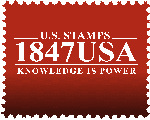
The United States Washington-Franklin Rotary Press Rarities
Christopher J. Palermo
April 9, 2019
Introduction
The Washington-Franklin series of definitive stamps, printed by the Bureau of Engraving and Printing (BEP) and issued by the Post Office Department from 1908 to 1922, consists of just 5 stamp designs featuring portraits of President Washington and Benjamin Franklin, but over 250 varieties with different catalog numbers. Like Great Britain Machins, collectors seem to either love the Washington-Franklins or hate them. In reality, identification is not difficult with some experience, and an unchecked old collection offers the thrill of looking for a rarity that might have hid for decades among more common material. While most Washington-Franklin stamps were printed in the millions and have little value, a few, including those printed using the rotary press on excess or “waste” stock, are uncommon to rare and command prices in the thousands of dollars. This paper explores why these stamps exist and how to identify them.
Explosion in Communications Meets Technological Change
The turn of the 19th century witnessed an explosion in communication within the United States as good economic conditions, westward expansion and population growth combined to make the mail service a critical link in the nation’s development. Penny postcards, or postal cards, and one-ounce letters were the text messages and instant messages of the day, dispatched by the millions and often collected and delivered two or more times per day. Stamps by the billions were needed, produced and consumed.
But by 1908, the previous United States definitive stamp series (the series of 1901) was looking dated with unnecessarily complex designs. The distinctive feature of the Washington-Franklin series is that it employs only two engraved heads set in ovals—Washington and Franklin in full profile—and reuses these portraits on every stamp denomination in the series. This is a significant change from previous definitive series, which had featured numerous different famous Americans, with each portrait image used for one denomination. However, Washington and Franklin had appeared on the first two American stamps of 1847, so the new Bureau Series also represented a return to the country’s design roots. During the next fifteen years, each of the eight stamp denominations available (with one exception) featured either Washington or Franklin.
In the first Washington–Franklin issues of 1908–11, each design used a pair of olive branches around the head profiles. After 1912, the Franklin-head issues appear with oak leaves near the bottom of the oval in the image. Olive branches and oak leaves are often used as symbols for peace (olive branches) and strength (oak leaves), though no significance was officially acknowledged in their use here. The five basic design types of the series are shown in Figure 1.
| Fig. 1 – Five Washington-Franklin Design Types |

|

|
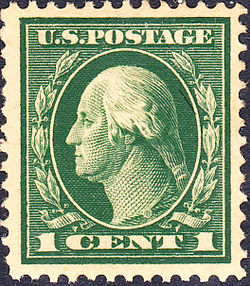
|
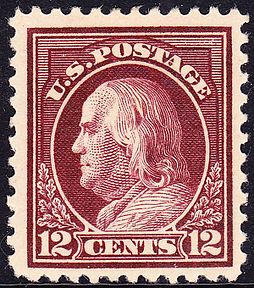
|
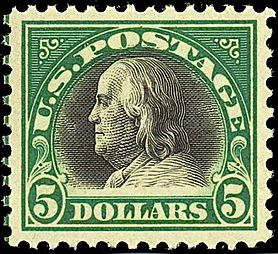
|
| Issue of 1908 |
Issue of 1908 |
Issue of 1912 |
Issue of 1917 |
Issue of 1918 |
The same engraving of either Washington or Franklin is used in five design types:
The first Washington–Franklin postage stamp to be released was a 2¢ stamp issued on November 16, 1908, Scott 332 (Figure 2). Other denominations soon followed and would
| Fig. 2 – Scott 332, Flat Plate Printing |
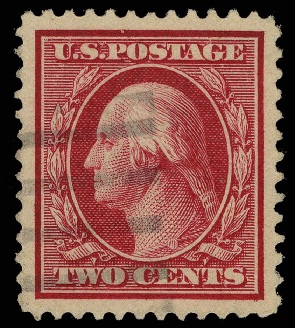
Source: usphila.com |
continue to appear through the first World War years, with the last Washington–Franklin postage stamp issued in 1923. The series thus survived for almost fifteen years, longer than any previous U. S. postage stamp series produced by a single printing organization.
For the first four designs, preparing printing plates for each stamp required two separate transfer phases. Two different steel dies were used, one containing the Washington or Franklin engraving, the other providing the framework and lettering. After every image on the steel plate had been impressed with both design components, the plate was heat-treated and hardened to prepare it for printing. In the lower-denomination Washington–Franklin Issues, 400 separate impressions appeared on a printing plate, referred to as a flat plate.
The different issues can be distinguished from one another by one or more of several factors: perforation gauge, the type of stamp paper—or, in some unusual varieties, by the printing method used. A deeper understanding of why certain Washington-Franklin issues exhibit certain features can be gained by studying the production problems experienced by the BEP, and its responses to those problems. Milestones in production are summarized in a flowchart shown in Appendix 2.
Phase 1 represents the introduction of the stamps from Scott 332 as identified above. (The “One Cent” value, Scott 331 was issued one month after 332, yet bears a lower Scott number.) On these first 1¢ and 2¢ denominations the amount of postage is worded as ONE CENT and as TWO CENTS, while on the remaining denominations (3¢ to 1 dollar) the amount of postage appears in numerals. Franklin is depicted only on the one cent denomination in this series; Washington appears on the values from two cents to 1-dollar. The designation “one cent” and “two cents” violated Universal Postal Union rules requiring denominations to use Arabic numerals and was corrected several years later.
The Phase 1 stamps had gauge 12 perforations and a watermark consisting of large double-lined letters spelling USPS, which the POD believed to weaken the sheets of stamps, causing the frequent separation of stamps at the Post Office before they even reached the customers. Two consequences of perforation gauge 12 were production of large amounts of waste paper in the form of punched hole bits, and weak perf lines that sometimes separated before stamps were sold. The BEP sought to address these problems in Phase 2, commencing in 1909, adopting a much less common type of bluish paper made of 35% rag stock combined with the usual wood pulp; it can readily be identified by its faint bluish-gray color. (Some contend that bluish paper contained only 10% rag stock.) Later in the same year the Post Office is supposed to have experimented with kaolin-impregnated (“China clay”) paper, but whether such a paper stock actually existed has become a matter of dispute.
Phase 3 involved changing the watermark to the single-line USPS format; this commenced in October 1910. The BEP hoped this would strengthen stamp paper and these changes were partly successful.
At Phase 4, the BEP corrected the violation of UPU rules by changing the 1¢ and 2¢ stamps to use Arabic numerals and using the Franklin portrait in higher-cost values to enable parcel post clerks to more rapidly determine that correct postage was paid when low-value and higher-value stamps had similar colors. Phase 5 involved technical changes in plate arrangement to address perforation waste. In Phase 6, the BEP switched to gauge 8 ½ and 10 perforations to address premature separation of sheets, but these proved to swing the pendulum too far in the direction of coarseness, resulting in an experiment with perforation 11 which this author terms Phase 7.
At Phase 8, the watermark was eliminated completely, since the single-line watermark played a minimal role in security and was believed to contribute to paper shrinkage. Thus, four or five basic paper types were used during the series. Two of these have different watermarks, while another paper-type had no watermarks, and bluish paper is the fourth. Kaolin paper is the controversial possible fifth type.
Perforation 11 was adopted on a wider basis in Phase 9. The demands for higher-speed production than permitted by flat plate printing spurred a change of offset printing in Phase 10, while the rotary press came online in 1920 at Phase 11. It is this final phase that yielded the rarities on which this paper focuses.
Flat Plate and Rotary Press Printing
Washington-Franklin stamps usually were generally printed by the flat-plate process, but several of the issues also employed other new and experimental printing methods, including use of the revolutionary rotary printing press and the offset printing process. Figure 3 illustrates a flat plate press of Hoe & Co. The flat plate press used four (4) flat plates on a moving pallet. Colored numbers indicate stages of movement of work.
| Fig. 3 – Hoe & Co. Flat Plate Press at BEP |
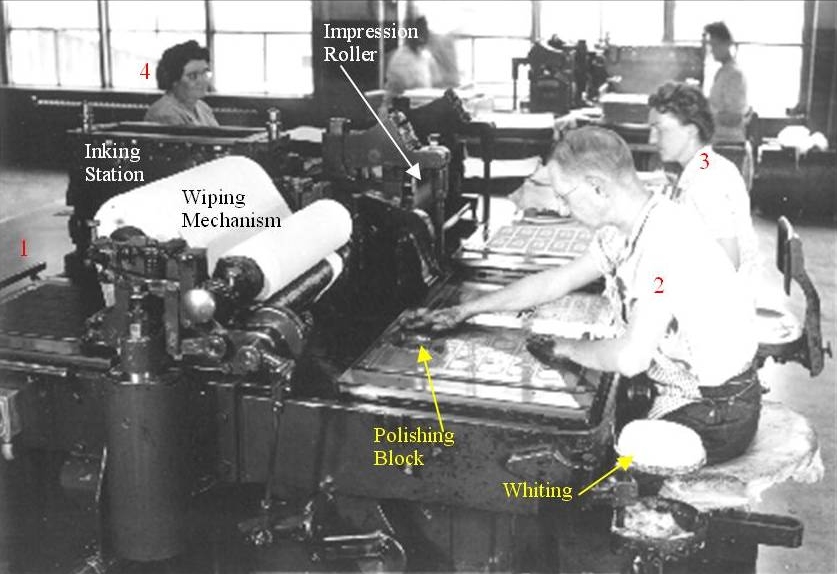
|
| . |
Using a printing technique employed with prior stamps from 1894, the paper used to print the Washington–Franklin issues was first dampened so that printing ink would be absorbed more thoroughly and evenly. However, this resulted in paper shrinkage when the sheets of stamps dried, causing the rows of stamps to be drawn closer together. Because the flat printing plates for this issue had individual stamp impressions spaced 2 mm apart, the resulting dried sheet would leave stamps spaced about 1½ mm apart, making it very difficult to line up rows of perforations accurately between the rows of stamps. Many sheets were issued with perforations somewhat off center, while roughly 20% of the sheets emerged with perforations so off-center that they were deemed unsalable and had to be destroyed.
Paper shrinkage would lead the Bureau to try various approaches to the problem in the following issues. Finding well-centered stamps with wide margins in any denomination in this early issue is a challenge for the collector and well centered examples command prices that far exceed average catalog values.
The rotary press used two semi-circular plates with a continuous web of paper. Figure 4 shows the Stickney rotary press of 1920.
| Fig. 4 – Stickney Rotary Press |
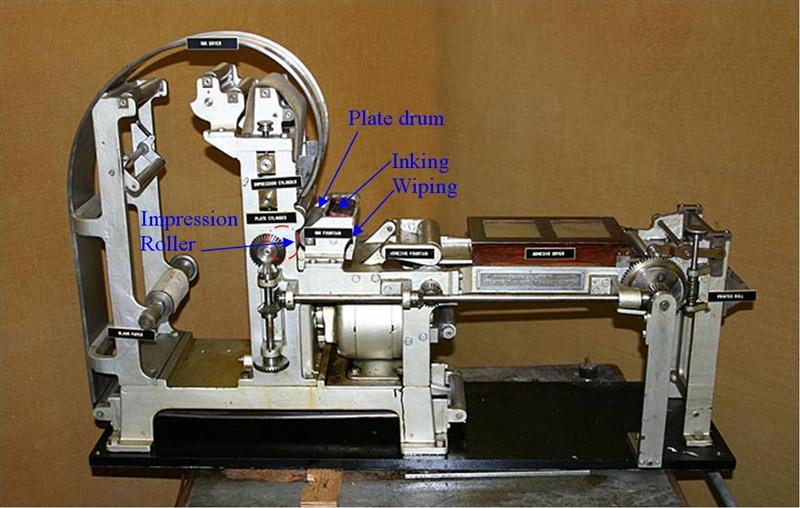
|
| . |
The rotary press was designed for rapid production. Importantly, the plates are wrapped around a cylindrical plate drum that could continuously impress stamp ink on long rolls or “webs” of paper. Plates were punched with gripper holes to mate with gripper claws on the plate drum. The plates were hardened only after attachment to the drum. These steps resulted in stretching the stamp designs on the plates.
Distinguishing Rotary Press Issues from Flat Plate and Offset Printings
The BEP first experimented with rotary press printing in 1915, and later made a substantial investment in rotary processing with the introduction of the Stickney rotary press in 1920, invented by Benjamin Stickney, a BEP employee.
The collector can distinguish rotary press printings from flat plate and offset printings by several principal criteria and one confirmation check.
After the foregoing tests, the image size may be measured, only for confirmation of the identification. Here “image” refers to the colored portion of the stamp including the perimeter rectangle. Rotary-press stamps have slightly different image dimensions than flat-plate or offset stamps arising from the use of a curved cylinder or drum. If the plate had been wrapped around the cylinder endwise or from top to bottom, then the design will be slightly longer in the vertical dimension. Alternately, if the plate was wrapped around sideways, then the design will be wider.
Compared to flat plate stamps, the size of the image of a rotary press stamp is wider or taller. For example, in Figure 5, the flat plate stamp has a design measuring 18.5mm to 19mm by 22mm, the middle stamp is 18.5mm to 19mm by 22.5mm to 23mm, and the right stamp is 19.5mm to 20mm by 22mm. The Scott Specialized catalogue gives these expected dimensions
| Fig. 5 – Flat Plate Compared to Rotary Press |
Left stamp – flat plate printing; middle stamp – rotary press printing, stretched vertically and showing plate film; right stamp – rotary press printing, stretched horizontally and showing plate film. Source: James Dire |

|
for various rotary press issues, including rarities, but the use of the size of the printed design, in millimeters, is a controversial basis for identifying rotary press stamps. Obviously, since ranges are given, the dimensions are not precise. Therefore, some experts consider the dimensions given in the Scott catalogue are advisory. Indeed, Mr. Frazier contends that the Scott Catalogue dimensions should be removed because they commonly mislead collectors. The reason is that measurement with a common ruler or even Vernier calipers is never precise enough for identification. As Mr. Frazier has written,
Unfortunately, leading experts as eminent as John Hotchner have recommended measurement, to amateur collectors, as a principal identification tool as recently as January 2019 in an article in Linn’s. (See references list at the end of this paper.) The author regards this advice as problematic. Instead, measurement with Vernier calipers, and not a ruler, should be done as a final confirmation after all other attributes are checked: perforation gauge; lack of setoff; plate tone; watermark; and other clues such as postmark date, if available on the stamp or a cover.
As an alternative to measurement, some experts recommend the template process. The four corners are diagonally cut off of a cheap stamp known to be flat plate, such as Scott 332. When such a template stamp is placed on a rotary press stamp, measurement differences are instantly apparent. Figure 6 illustrates the process. Additional information is also available in this article.
| Fig. 6 – Flat Plate Template Stamp with Rotary |
| Image: Kenmore Stamp Company |
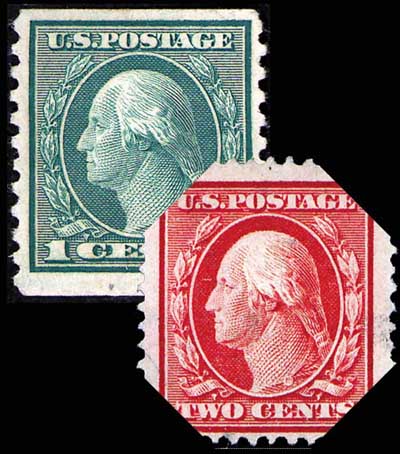
|
It should also be noted that the top and bottom perforations of vertical format rotary press sheet stamps as well as coil perforations must be aligned between rows because perforations across the web were punched by pins in rows on a cylinder.
What are Sheet Waste and Coil Waste?
From 1919 to 1923 the BEP used “waste” stamps that had been printed on rotary presses in new processing and released them to the public. Rotary press waste that was ultimately issued as postage resulted in some of the rarest US stamps, denoted Scott 544, 594, 596 and 613.
The term “waste” is initially misleading. Rotary press waste did not consist of scrap taken up from trash bins or the floor. Instead, rotary press stamps had been properly printed, but withdrawn from manufacture due to quality control or standards problems. At the beginning or end of a coil stamp print run from 170-subject plates, a quantity of leading or trailing paper was printed that was too short to slit and roll into 500-stamp coils. Thus, a better term than “waste” might be “short ends” or “excess production.” The Scott Catalogue defines “coil waste” as:
Sheet waste, in contrast, occurred when the BEP perforated sheets of stamps that had been either printed imperforate, or perforated in a single direction, but set aside because of issues such as insufficient margin. Sheet stamps printed from 400-subject plates also produced some excess that was set aside. Interestingly, the Scott Catalogue does not define “sheet waste.”
In 1919 the BEP decided to use up this waste by perforating and cutting the sheets into panes. The rationale for the decision is unclear but may have been driven by sheer demand for stamps, as the resulting stamps appeared late in the year when demand for holiday mailings would have been high. Scott 538-541 are the first stamps issued using this process. They were coil waste sheets that had been already perforated gauge 10 in one direction. They were produced from the 170 subject horizontal coil plates which had been put to use for the rotary coils, Scott #s 597 and 599. Wide rotary press stamps 545 and 546 were from imperforate coil waste. Tall rotary press stamps Scott 542 and 543 were the first rotary press sheet stamps. By 1919, the BEP had changed to 11-gauge perforation for flat plate stamps, so the waste sheets were run through the 11-gauge perforator. This perforation occurred either horizontally, or vertically, or both, depending on whether the waste sheets had been perforated when they were originally produced.
In 1923, coil waste from the new 1c and 2c rotary press series were similarly perforated and are denoted as Scott 578-579 and 594-595. Figure 7 shows Scott 578. These were the last of the coil waste issues.
| Fig. 7 – Rotary Press Coil Waste, Scott 578 & 579, on Album Page |
Source: Author’s collection |
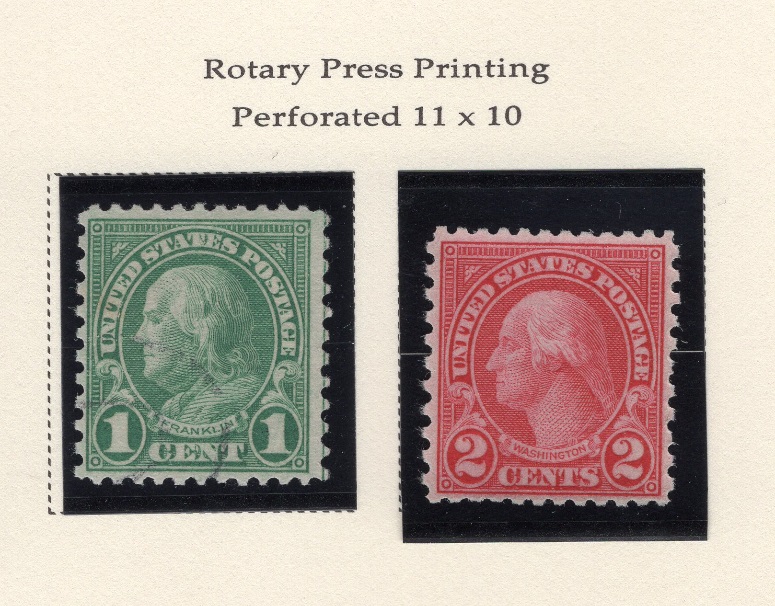
|
These two stamps are extremely difficult to find well centered with any kind of margins to speak of; the example of Scott 579 in Fig. 5 is an exception.
Again in 1924 the BEP selected coil waste sheets for further production. However, these coil waste sheets had not been perforated previously. They were placed on the flat plate perforator, run in both directions and have perforation gauge 11 x 11. The BEP did not consider these stamps to be a different issue, so they were not formally announced. Instead, collectors discovered them. For example, the 1¢ stamp (Scott 594, Figure 8) was discovered by a sharp-eyed New York collector who thought that the stamps looked a bit different. Most, if not all, of the 1¢ stamps originated at the Madison Square Station Post Office in New York. Researchers believe that 60 sheets of 170 subjects, or 10,200 stamps, were printed but less than three dozen are accounted for today. The possibility of finding one of these rarities on a cover or postcard remains even decades later.
| Fig. 8 – Scott 594 |
Source: Robert A. Siegel Auction Galleries, Inc. |
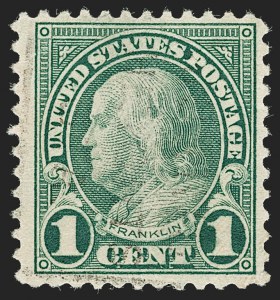
|
The 2¢ stamp (Scott 595; see Figure 9) was discovered while on sale at the Philadelphia and New York City post offices. The centering of these stamps was so poor that ample supplies were not sent to post offices, but the estimated printing total of 100,000 means that many collectors can acquire this issue.
| Fig. 9 – Scott 595 on Album Page |
| Source: Author’s collection |
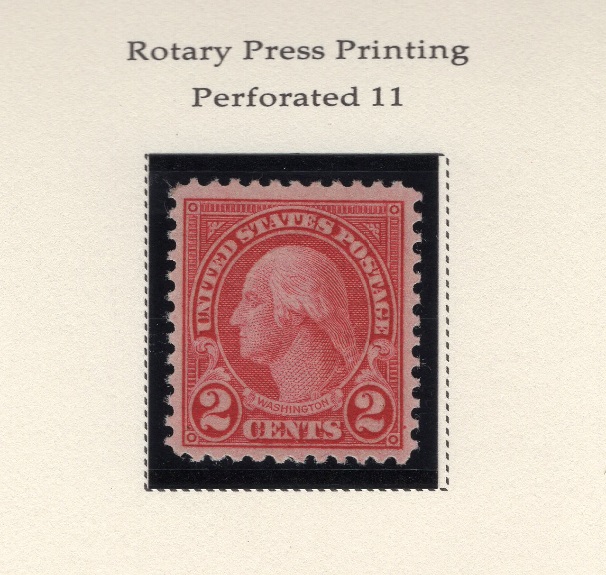
|
The first rotary-press stamp made from sheet waste with gauge 11 perforations is Scott 544 (Figure 10). Some researchers believe that waste from the rotary printing of this stamp was perforated 11 at two different times, one of which coincided with the 1923 production of Scott 596 and 613.
| Fig. 10 – Scott 544 (Certified Example) on Album Page |
| Source: Author’s collection |
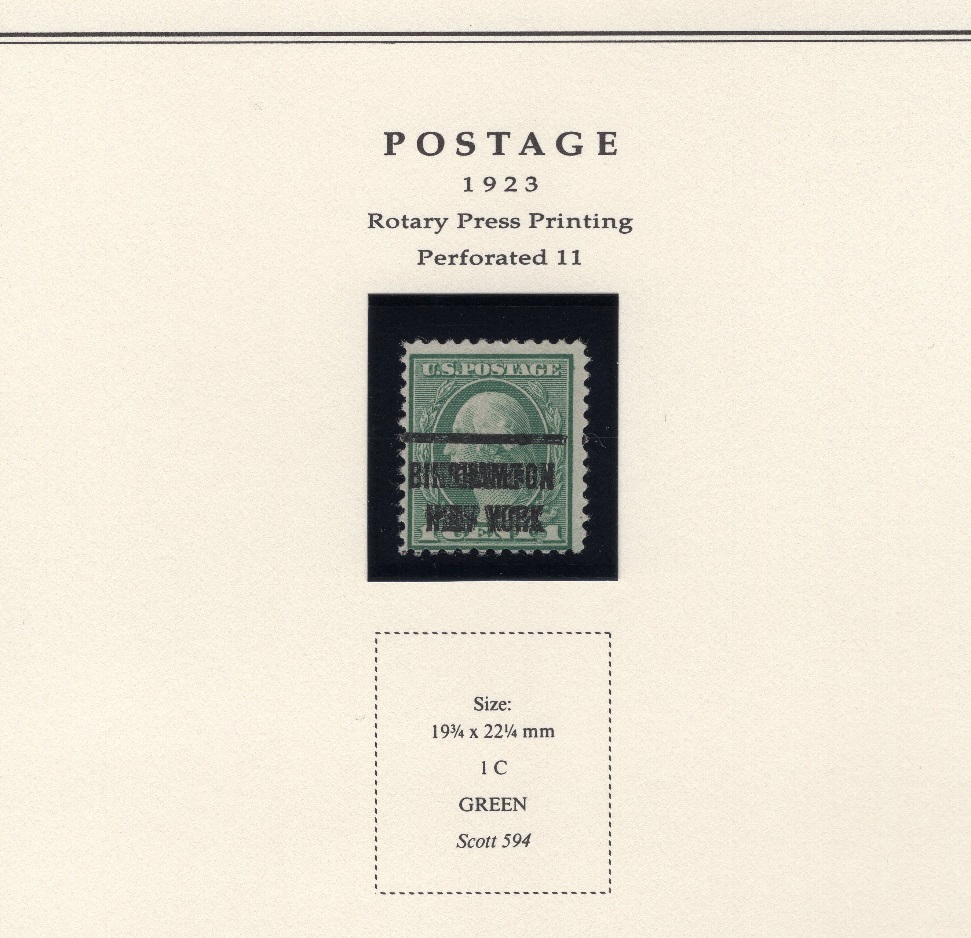
|
The 1¢ green, Scott 594, was made from waste originally printed for coils.
The rarer Scott 596 (Figure 11) is waste from a vertical rotary printing used to make sheet stamps, which is confirmed by the existence of precanceled examples. It was discovered in
| Fig. 11 – Scott 596 |
| Source: Robert A. Siegel Auction Galleries, Inc. |
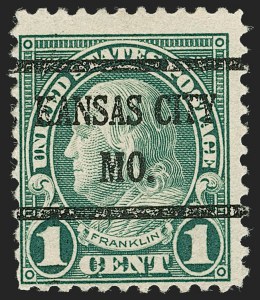
|
1962, almost 40 years after its issuance. The difference between the Scott 594 and 596 is in measurements. Scott 594 measures 19 ¾ mm x 22 ¼ mm while the latter measures 19 ¼ mm x 22 ½ mm. The Siegel census of Scott 596 includes only 13 used examples; no unused copies are known. Five carry a machine cancel and the others are precancelled Kansas City, MO. The Bureau did not release any production figures for this rarity but educated guesses place the number at 10,000.
Both Scott 594 and 596 can be identified using the template process. Scott 594 has the same perforations as the flat plate stamp Scott 552, but is the design size of Scott 597. Both of 552 and 597 are cheap stamps and readily available. The same process can be used for Scott 596; check it against Scott 552 for perforation gauge but compare the size of design to Scott 632.
The Bureau rotary press rotaries have delighted and challenged collectors for nearly a century. Identifying criteria for these stamps can be learned by any serious collector with the investment of a reasonable amount of time. Unfortunately, some collectors take a more casual approach, appearing to think that almost any common stamp must be a 594 or 596. For these collectors and others, Appendix 1 presents an overview of how to determine whether a rotary press stamp is common, or a “jackpot.” Regardless of the collector’s fortune in hunting these stamps, study of the Washington-Franklin series is bound to be rewarding, providing a fascinating review of how government struggled to address the technical challenges of early 20th century printing.
* * *
References
Amos Publishing Co., Inc., “Scott Specialized Catalogue of United States Stamps and Covers,” 2016 ed., pp. 4-44.
P. Mosiondz, “More about Coil Waste,” American Stamp Dealer & Collector, online at https://www.americanstampdealer.com/SubMenu/More_on_U_S_Coil_Waste.aspx.
L. Weiss, “The Washington-Franklin Heads: Simplified!”, The United States Specialist (Journal of United States Stamp Society), January 1991.
J. Dire, “Washington-Franklin Stamps of 1908-1922,” online at http://www.jamesdire.net/W-F.html.
Anonymous (probably S. Trepel), “1923 Rotary Press Perf 11 Rarities,” Robert A. Siegel Auction Galleries, Inc., online at http://siegelauctions.com/enc/pdf/1923Rotary.pdf
Anonymous, Sale 1180 — The David Wingate Collection of United States Stamps, 11-12 April, 2018, Category — Rotary Waste Rarities and Later Issues (Scott 594, 596, 613), Robert A. Siegel Auction Galleries, Inc., online at https://siegelauctions.com/lots.php?year=2018&sale_no=1180&page_no=36
Anonymous, “Coil Waste,” Wikipedia, online at https://en.wikipedia.org/wiki/Coil_waste
Anonymous, “Answering the question of how to identify flat plate and rotary stamps,” Linn’s Stamp News, January 22, 2018, available online at https://www.linns.com/news/us-stamps-postal-history/2018/january/how-to-identify-flat-plate-rotary-stamps.html
Anonymous, “Washington-Franklin Issues,” Wikiwand, available online at https://www.wikiwand.com/en/Washington%E2%80%93Franklin_Issues
K. Lawrence, “Is your 1¢ green Franklin stamp Scott 594 or 596? If it is, you have a winner”, Linn’s Stamp News, January 30, 2015, online at https://www.linns.com/news/us-stamps-postal-history/2015/january/is-your-1-green-franklin-stamp-scott-594-or-596.html
J. Hotchner, February 1, 2019, “Understanding Fourth Bureau Issue coil waste and sheet waste stamps,” online at https://www.linns.com/news/us-stamps-postal-history/understanding-fourth-bureau-issue-coil-waste-and-sheet-waste-stamps
Appendix 1
Do I have a 594 or 596? –A Collector’s Guide to Identification
Recently, public stamp discussion forums have received dozens of inquiries from collectors about whether a green 1¢ United States stamp depicting Benjamin Franklin is a rare, valuable stamp. In all cases, the answer has been no, and responding to these inquiries has required repetitive communication of the same information about how to identify these stamps. The information in this page consolidates the advice that has been given in numerous prior discussions and, if studied and applied by you, will resolve your questions about whether you possess one of the rare stamps.
The 1924 1¢ rotary press United States stamps identified by catalog numbers 594 and 596 have tantalized generations of collectors with their high catalog values and auction price realizations. Thousands of collectors have thought they possessed one of these rarities, but they virtually never do. There are many ways to mis-identify these stamps, but with education, you can understand how to examine them and what attributes to look for.
Begin with education about the origin and production of the stamps.
To understand why these stamps are rare, start with educating yourself about how they entered the philatelic universe. Linn’s Stamp News published an excellent article on these stamps a few years ago about the creation and production of these stamps and understanding these issues will enrich the time you spend identifying candidate stamps. The attached white paper also tells the story in depth.
In brief, stamps with catalog number 581 and 596 both were printed on the Bureau of Engraving and Printing's Stickney rotary presses, which were new in 1924. These machines did the printing gumming and perforation in a continuous operation. Evidently a small amount of printed and gummed web was removed in the early set-up and run of this stamp. Rather than destroying it, it was cut into sheets and perforated on perforation 11 flat plate perforators. The total quantity produced is unknown but was probably just a few thousand, compared to billions of flat plate stamps and stamps that were perforated with gauges other than 11.
Avoid “confirmation bias”
The excitement of suspecting that you may own a rarity can result in seriously clouded judgment, to the point of irrationally convincing yourself that you possess a rarity when the facts are against you. Rare stamps are just that—rare. The chance that you possess one of the 1924 rotary press rarities is extremely low, effectively near zero. (Mathematically, it’s about 100 million to 1.) Therefore, as you examine your candidate stamps, assume that they are NOT the rarities, and seek to confirm that assumption. Do not presume that they ARE the rarities and seek to confirm that they are—that approach will cause you to willfully ignore evidence to the contrary.
Do not use measurements with a ruler, or even calipers
Some specialized stamp catalogs, and other sources, state that catalog number 596 should have a design measuring about 19.25 mm x 22.5 mm. These measurements, as reported in the catalogs, have never been intended as an objective way to identify the rotary press rarities, and have caused many collectors to be disappointed because thousands of stamps have these measurements but are NOT the rare varieties. Some commentators view the catalog information as misleading and outmoded. In any case, a metal or wood ruler is not accurate enough to measure the height of stamps and the dimensions in the catalog are not accurate enough to be useful. The measurements are merely a general guideline. Furthermore, the measuring tools available to collectors are usually never precise enough to use design measurements as a basis of identification. The stamp must have many other attributes for measurements to become even relevant. Therefore, put away the ruler and calipers and do not rely on measurement for any aspect of identification.
If you feel compelled to measure, the best way to find out if your stamp happens to be a rotary press stamp is to compare it with a loose flat plate stamp such as catalog 552. The design height would have to be at least a frame line taller. Ideally, match the height with a rotary press perf 10 stamp such as catalog number 581 or a perf 11 x 10 1/2 stamp such as catalog number 632. Note that "perf 11" is an approximation (see below). A rotary press perf 11 stamp is not the same as a flat plate perf 11 on 552, also used on the coil waste stamp (594) or sheet waste stamp (596).
Start with correct use of a perforation gauge and accurate perforation measurements
The first attribute of catalog number 596 is that it has perforations of gauge 11 on all sides. This does not mean 11 holes, or 11 tips, on any side. It means the gauge of the perforations is 11; gauge is defined as the number of perforation holes in a linear distance of 2 cm.
The best way to find out if your stamp happens to be a rotary press stamp is to compare it with a loose flat plate stamp such as catalog 552. The perforations should match exactly.
If you don’t already own one, purchase or obtain an accurate specialist perforation gauge such as the Kisulas gauge. Common metal perforation gauges are not designed to accurately measure perforations on classic and early 20th century US stamps. A specialty gauge or another US stamp with the same perforations is needed. In a pinch, the printable perforation gauge provided on StampSmarter can be used. Align the candidate stamp so that the perf tips match the black printed tips shown on the gauge. Check perf gauge 10 1/2 first, not perf 11.
A rough gauge can be obtained by counting the number of holes across a short (horizontal) side of the stamp; if there are half-holes, they must be included in the total. However, the most effective way to measure US stamps is to use another stamp with known characteristics to compare height, width or perforations.
Virtually every stamp that a collector thinks is a 596 actually has a perforation gauge that is not 11 by 11, but something else. Examples include catalog number 578, which has gauge 11 by 10 perforations; 581, gauge 10 by 10; and 632, gauge 11 by 10½. These stamps are extremely common and therefore have low value.
Does your stamp have ink artifacts on the back?
Green ink artifacts or flecks on the back of the stamp indicate that the stamp was produced using flat plate printing. This effect is termed setoff, and occurred when wet, freshly printed sheets of stamps were stacked flat on top of one another. In contrast, the stamps with catalog numbers 596 and 594 were printed using a cylindrical rotary press in a continuous web, and sheets were not stacked in a wet manner that made them subject to setoff. The presence of setoff on the back of your stamp eliminates it as a candidate for 596 or 594. If the stamp has setoff and is perforated 11 x 11, it is catalog number 552, a common stamp.
Is there a 3-line KANSAS CITY MO precancel?
The vast majority of certified 596 stamps were precanceled with a 3-line KANSAS CITY MO marking. If your stamp does not have such a precancel, the likelihood that it is 596 goes down. The style and print quality of a precancel should not be confused with a roller cancel. Precancels were made from metal plates that printed over finished stamps, as part of the production process. Roller cancels were applied at post offices to cancel stamps on parcels and other irregular articles that would not receive a good impression from a rigid metal device. Roller cancels often were made of rubber, like a rubber stamp, and will be more irregular and blurry than a printed precancel.
Stamps with anything other than a Kansas City precancel are especially suspect. Genuine examples with wavy-line cancellations have been offered only three times at auction in over 60 years. The wavy line cancel stamp was essentially "discovered" by two philatelists when they noticed that the dimensions differed from Scott 594, the other rotary press perf 11 waste issue. The story is told in Opinions, published by The Philatelic Foundation. One such stamp was sold in Siegel’s 1982 Rarities sale and eventually entered the "Westport" collection formed by the Weills for a midwestern client. When the Westport collection was sold at auction by Christie's, this stamp was acquired by a Texas collector. That collection was sold privately a few years ago, and Alan Whitman acquired the stamp through Sonny Hagendorf (Columbian Stamp Co.).
Learn about the correct color shades for the stamp
In general, most stamps of catalog numbers 596 and 594 will have a dull gray-green color, and not bright yellow-green. However, comparing colors and shades using computer-based images is always inaccurate, because of differences in scanner settings, computer settings, lighting or even fading or other effects on the subject stamps. Therefore, while bright yellow-green stamps are usually instantly eliminated as 596 or 594 candidates based on both color and the other attributes discussed in this page, examination by an expert who has seen many such stamps is often the only way to verify that a candidate stamp has the correct shade. As you’ve learned from the article in Linn’s, the stamp having catalog number 596 was manufactured from sheet waste of stamps printed as catalog number 581. The 1¢ vertical coil, catalog number 604, is slightly taller than the perf 10 rotary press sheet stamp of catalog number 581. Catalog number 594 shades will match early printings of the 1¢ horizontal coil, catalog 597. Coil and sheet waste production ceased before the switch to perf 11 x 10 1/2 sheet stamps and brighter colors.
Scott 596 is the same size and color as the rotary press perf 10 sheet stamp, Scott 581. They are perf 11, matching flat plate issues of the period. More than half the population reported on the Siegel Auction web site are precancelled KANSAS CITY with MO. on the second line. Fake examples with colors more typical of Scott 632 have been fraudulently created by perforating rotary press booklet pane singles with jumbo margins.
Appendix 2
Milestones in BEP Production of
1908-1922 Washington-Franklin Stamps


